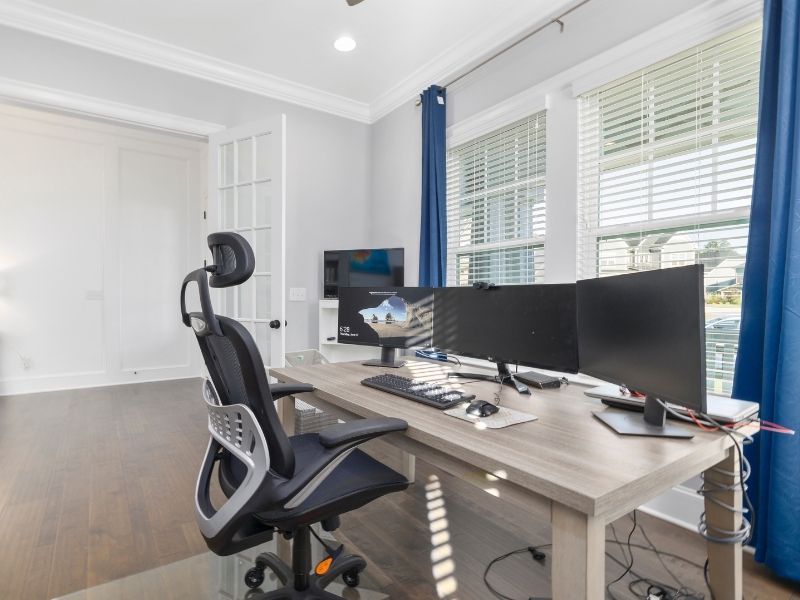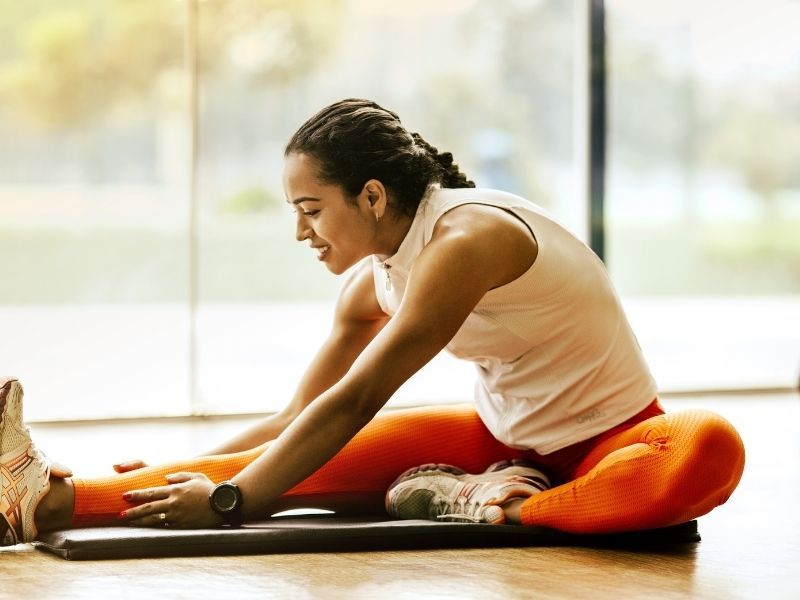How To Pick The Best Chair For SI Joint Pain

Sitting with SI joint pain for any length of time can be very uncomfortable, especially if your job requires it. The type of chair you sit in can make a big difference, but its important to pick the best chair for si joint pain specifically.
Let’s take a look at the most important factors and tips when choosing the best office chair.
Can Sitting Aggravate SI Joint Pain?
Before we dive into chair options, let’s address the big question; is sitting bad for your back and si joints?
Contrary to popular belief, there is no evidence that sitting is bad for the spine. While there may be a strong correlation between lack of overall movement, being sedentary and having increased likelihood of aches and pains, sitting by itself is fine.
The problem is when there is aggravation of joints, tissues and nerves, sitting can be uncomfortable.
To make the body happy, we need 3 things: Blood circulation, oxygen, and movement. Sitting in one spot for long periods of time will certainly reduce the ability to do these things.
This leads us to…
What Is The Best Sitting Position For SI Joint Pain?
Human beings are meant to move, not just sit or stand in one position for a long time. So, when we consider the question, there isn’t one best position to sit in overall.
The same is true when dealing with sacroiliac joint pain. As mentioned in other articles, the SI joints do not move much (if at all in many cases!), so we need to be mindful of the joints that are nearby.
This means the lumbar spine and the hips. These joints are HIGHLY mobile and meant to move. This often leads to a number of different positions that can be assumed when sitting. Thus, the variety of options when it comes to available chair options.
When we look at the pelvis, we should consider the primary positions that influence these joints.
The forward and backward tilting of the pelvis (Anterior and Posterior) create the movements of nutation and counternutation of the sacrum. This directly influences the position of the lower lumbar spine (flexion and extension) and also the hips (relative flexion).


A pelvis + hip that is elevated on one side or the other will also contribute to a rotation of the pelvis.

These are the variables we have to play with when it comes to sitting positioning.
Considerations When Choosing A Chair For SI Joint Pain
When considering the best chair for si joint pain, here are a few factors that can influence the ability of the chair to be most comfortable.
- Seat height and depth
Just like any chair, there is no universal fit. The height of the user is definitely one of the most important considerations.
- Lumbar support
Lumbar supports can be built into the chair itself, OR added on. Personally, I’m not a huge fan of built-in lumbar supports, as I find them most frequently inadequate. I’d rather add on something like a Mckenzie Super Roll. In this case, the chair needs to be able to accommodate this addition.
- Firmness of the seat
Some people like very firm seats, while others prefer something more like memory foam. Additionally, the shape of the seat can be an important component, for example, “bucket” type seats are very uncomfortable for some si joint pain sufferers.
- Armrests
Armrests are a personal preference as well. On average, I find that individuals that are shorter don’t like them as well as taller people. They won’t impact SI joint pain much either way.
Types Of Chairs Available
- Office chairs
Standard office chairs come in all sorts of shapes and sizes. Here are some of the top recommendations for office chairs.
- Exercise ball chairs
Exercise ball chairs can be good for short term, but in general I find most SI joint pain sufferers don’t like spending too much time on them, so unless you really like them, they may not be worth the money.
- Kneeling chairs
Kneeling chairs in my experience are some of the most effective at relieving lower back and hip pain. The problem, however, is using them for a long period of time.
The pressure on the knee contact points can be annoying. Since there is no back support, there is no way to lean back, but due to the low position of the knees and forward tilting of the pelvis, being upright is less effortful.
- Saddle chairs
Saddle chairs are interesting in how they disperse sitting forces. Although I have no personal experience with these, the reviews are generally good and worth a try.
- Seat cushions or wedges
Seat cushions and wedges are worth noting. The chair you select is important, but since chairs can rarely be “perfect”, components of it can be easy modified with add-ons. I mentioned the lumbar support above, but the seat can be make softer or firmer, and wedges can be used to elevate the hips relative to the knees.
Steps For Testing The Chair
Whenever possible, you’ll want to be able to test out the chair in person before committing to the purchase. This will give you the opportunity to test it out and check the level of comfort and the available adjustments.
Of course this isn’t ALWAYS possible, because many of the best chairs are only available online, but many of them do have a return policy. Sometimes even when you have done all your research, you just don’t know until you sit in it.
Here is a short checklist of things to test when trying out a chair for si joint pain.
- Sit in the chair and pay attention to your posture
Does it feel easier to sit upright? Is your pelvis in more posterior or anterior pelvic tilt?
- Test the lumbar support by leaning back in the chair
What is the depth of the support? Is it aggressive or minimal? Is it positioned in the right spot for your body?
- Adjust the chair to your preferred height and depth
Can your feet make flat contact on the floor? Is the depth of the chair too much or too little for the length of your thighs?
General Tips For Body Alignment When Sitting
When sitting in your office chair, you need to be able to keep your feet flat on the ground. Dangling feet can alter your center of gravity and increase unwanted excess muscle activity and stress on the joints.
Your knees should be at minimum positioned at 90 degrees, if not more. If more spinal extension/anterior pelvic tilt is desired, the knees should be lower than the hips. This often means having to position oneself closer to the edge of the chair.
Crossing your legs can add to si joint discomfort. This may be due to changing the positioning of the body or stretch on the hip tissues.
Avoid sitting in ONE spot for long periods of time. Shifting around in your seat is completely normal and desirable. Remember, nerves need blood circulation, and that means movement!
Here is a simple movement you can do throughout the day:
Conclusion
Finding the right chair for si joint pain is an individualized process. You need to keep into considering the various factors listed above, but also your own needs and preferences.
You may need to test out a few options, but armed with having done your research ahead of time, you’ll be in the best position to make the best decision.
Related Articles
5 Special Tests To Uncover SI Joint Dysfunction
How To Know If Your SI Joints Are Causing Your Pain
Sacroiliac Joint Belts – Do They Work?
How To Sit With SI Joint Pain?
Best Mattresses For SI Joint Pain
Sam Visnic
I’ve spent my life studying the fundamental aspects of human health with a focus on movement and clinical massage therapy. In a world of specialists, surgical procedures, drugs and quick fix remedies, I’m committed to finding and developing strategies that help people stuck at the “gap”. Over the last 20 years I’ve studied dozens of systems and methodologies for uncovering the root cause of aches and pains, along with postural and movement issues. Pain science, the art and science of hands-on soft tissue massage techniques, myofascial release, and coaching movement is essential in my practice. Integrating different methods but above all deciphering WHEN to use different techniques with different people and situations, along with integration of movements that people want to be able to do again is the key to long term success with my incredible track record with clients. Understanding the various elements that contribute to conditions and the power of communication and education makes my Release Muscle Therapy program separate from other hands-on therapy approaches.
Blogs You May Be Interested In
Categories
-
Deep Gluteal Pain Syndrome
-
Deltoids
-
Fallbrook
-
Foam Rolling
-
Glutes
-
Hamstrings
-
Hypnosis For Pain
-
Lats
-
Levator Scapulae
-
Lifestyle
-
Massage Therapy
-
Mobility
-
Movement and Exercise
-
Murrieta
-
Muscles
-
Nutrition
-
Obliques
-
Pain
-
Pectorals
-
Piriformis
-
Plantar Fasciitis
-
Product Review
-
Psoas
-
Quadratus Lumborum
-
Quadriceps
-
Rhomboids
-
Serratus Anterior
-
SI Joint
-
Sternocleidomastoid
-
Stretching
-
Subscapularis
-
Temecula
-
TMJ
-
Trapezius
-
Uncategorized




















